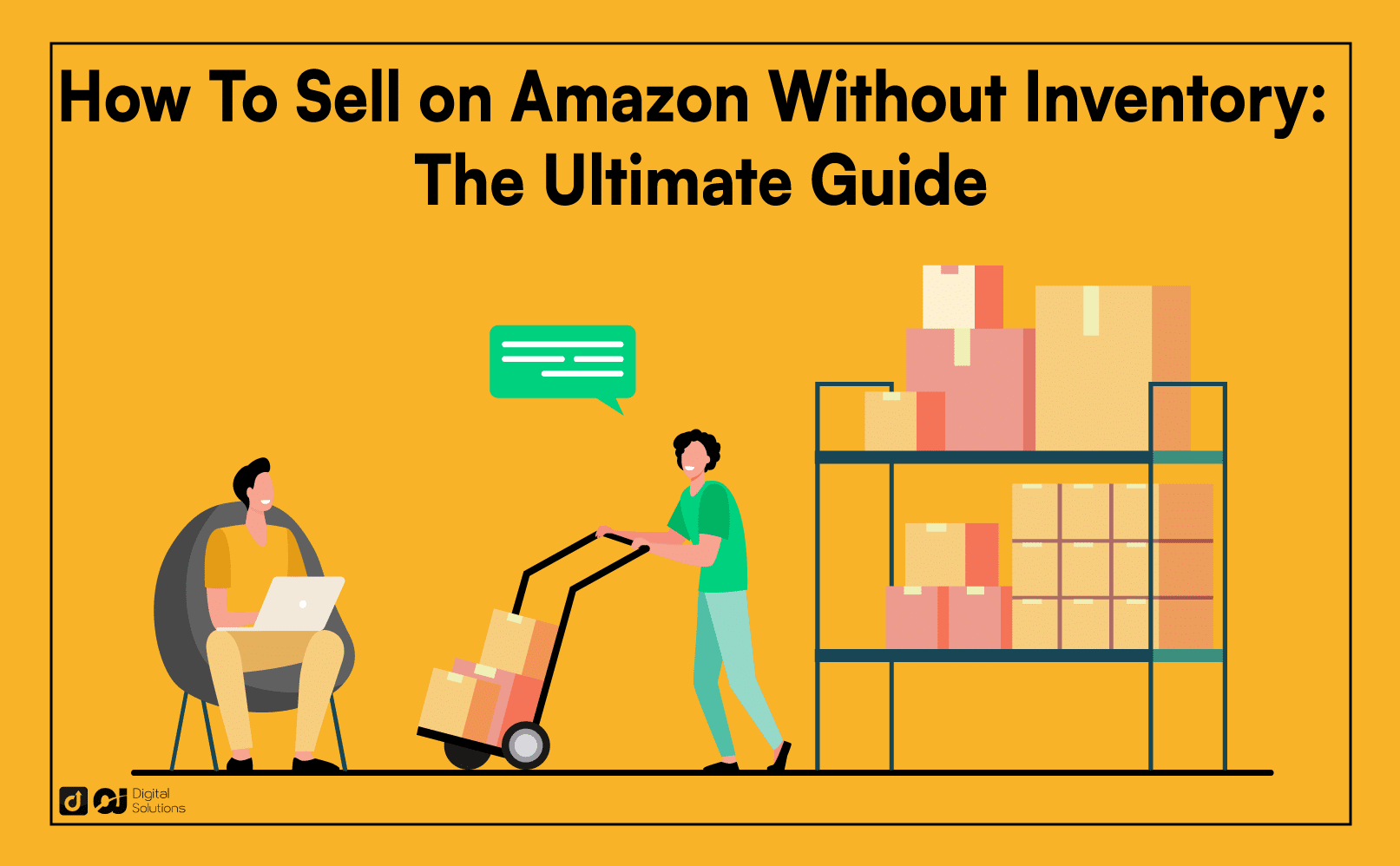Do you want to take advantage of Amazon’s huge customer base but don’t have sufficient capital to buy inventory or maintain a warehouse?
If you answered yes, you’ve come to the right place.
In this article, I’ll teach you how to sell on Amazon without inventory in different ways. I’ll detail the advantages and disadvantages of each method to help you determine which is right for you.
By the end, you’ll know how to start selling on Amazon without inventory.
Let’s begin.
How To Sell on Amazon Without Inventory
Did you know that you can make money on Amazon without inventory? With these methods, selling products online has lower barriers to entry:
Amazon Dropshipping
Merch on Demand by Amazon
Kindle Publishing (Amazon Digital Products)
You can also go into ecommerce selling by having a third-party business entity manage inventory through the following methods:
Amazon FBA Program
Third-party logistics or 3PL company
| Amazon Dropshipping | Merch by Amazon | Sell Digital Products | Amazon FBA | Third-Party Logistics (3PL) Company | |
|---|---|---|---|---|---|
How It Works | Amazon store owners sell goods that they do not keep in stock. So when a customer orders an item, they send the order to their dropshipping partner (i.e., supplier or manufacturer) to ship the goods directly to the buyer. | This free, on-demand printing service allows you to create and list original designs on Amazon. You receive royalties every time a customer buys your designs. | You can sell retail digital services and products like ebooks, songs, audio tracks, software, and apps on Amazon. | This service allows you to outsource order fulfillment to Amazon. Thus, you need to send your products to its warehouse so it can store, pack, and ship orders directly to your customers. | Your 3PL service provider handles your logistics and supply chain operations, from managing inventory and packing product orders to shipping them directly to your customers. |
Pros | Low upfront cost and simplified inventory management and fulfillment processes | Free sign-up and royalties | Low upfront cost and excellent passive income stream | Simplified inventory management and fulfillment processes, faster shipment, and lower shipping rates | Simplified inventory management and fulfillment processes, faster shipment, and lower shipping rates |
Cons | Highly competitive market and little control over the product quality, packaging, and shipment | Invitation basis platform and competitive market | Prone to piracy and a highly competitive market | Higher fees, complex sales tax, and higher product returns | Higher upfront costs and complex sales tax |
Do You Have To Buy Physical Inventory? | No | No | No | Yes | Yes |
Let’s discuss each option below.
Use Amazon Dropshipping.
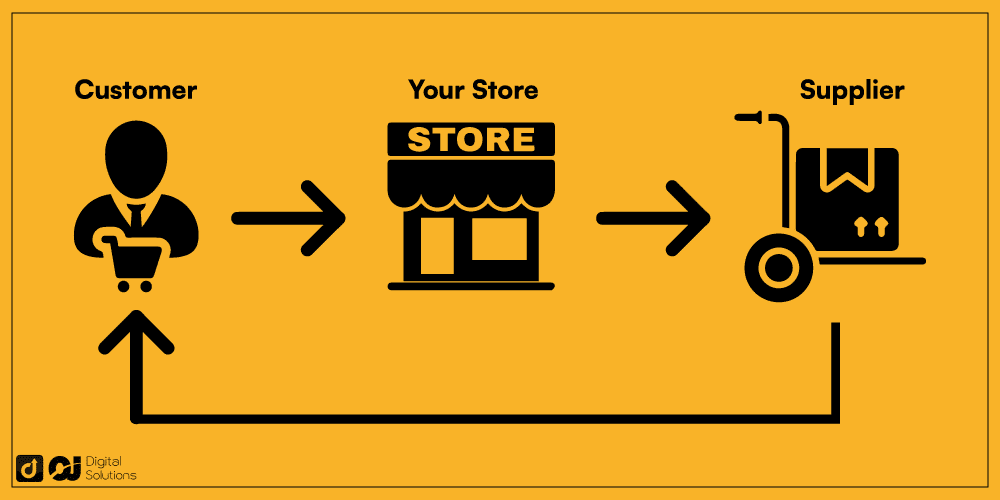
Amazon dropshipping is worth considering if you want to make money without buying and storing products.
With this method, you partner with a supplier or manufacturer that ships the products directly to the buyers on your behalf.
In a dropshipping business model, your main role is to provide marketing and customer service. Additionally, it’s your job to establish a brand on the Amazon platform by creating interesting content and product listings to entice customers.
Once your customers order from your Amazon store, you forward these to your supplier and pay the wholesale price. Then, your supplier will fulfill these orders for you.
Here’s how to sell on Amazon without buying product stocks through the dropshipping model.
1- Create an Amazon seller account. Navigate to sellercentral.amazon.com and provide your address, tax information, credit card, and personal details.
2- Conduct product research. Look for products to sell. A good rule of thumb is to find products with high demand and relatively low competition.
3- Wait for Amazon to approve your account. Some categories like jewelry, music, grocery, and fashion require approval before you can set up your Amazon store.
4- Find the best dropshipping suppliers. Additionally, make sure you are the seller of record.
5- Conduct keyword research to optimize your listings and improve their visibility. One way to do this is to type a keyword in Amazon’s search bar and wait for the auto-complete menu to appear with word recommendations.
You may also use popular keyword tools like Helium 10, JungleScout, and Sellics.
6- List your products. Ensure that you also include multiple quality photos, relevant keywords, and other content to make your listing more enticing to your customers.
7- Use Amazon’s Seller Central or its mobile app version. That way, you can monitor the performance of your Amazon store.
Note: You must subscribe to an ecommerce platform that supports dropshipping service and integrates with Amazon.
Shopify is arguably the best choice because it is also compatible with other popular marketplaces like eBay and Etsy.
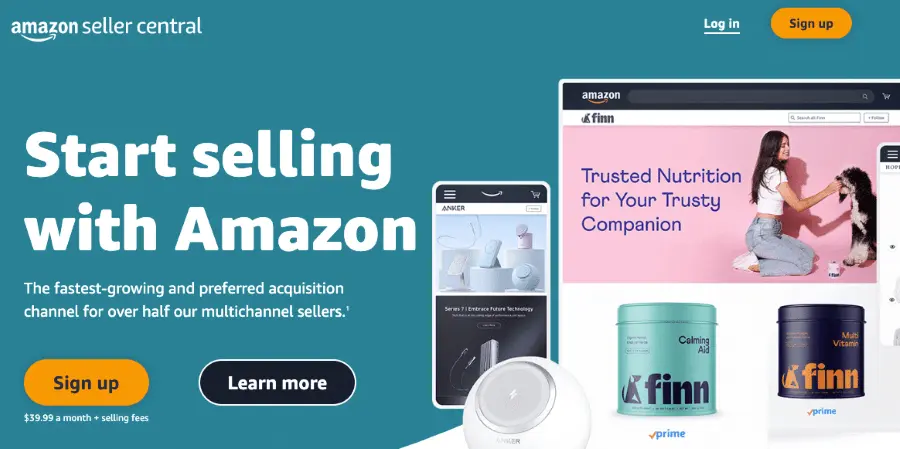
Pros of Dropshipping Products on Amazon
You can take advantage of Amazon’s diverse product categories.
You can access a large and loyal customer base as an Amazon store owner with dropshipping partners.
You can ship products to customers without actually holding your inventory. In short, you don’t have to worry about any warehousing costs.
Your customers enjoy faster deliveries and better customer service.
When you start Amazon dropshipping, you enjoy lower operating costs because you don’t carry inventory or pay for warehouse space.
Cons of Dropshipping Service on Amazon
If you rely on overseas suppliers or manufacturers, the products may take a few weeks to reach the buyer unless you have taken additional steps to ensure faster delivery.
You need to lower your price significantly to stay competitive.
Since the dropshipping model has a low barrier to entry, you face a saturated market.
Since your dropshipping partner (i.e., supplier or manufacturer) ships the item to the buyer, you have no control over the product quality.
The Cost of Dropshipping on Amazon
The dropshipping fees vary, depending on your chosen suppliers and marketing strategy. Sometimes, you must only pay Amazon seller fees.
If you want a comprehensive dropshipping solution, you can create your own e-commerce space with Shopify, then integrate it with your Amazon store.
Here’s a quick look at what fees you need to pay to start dropshipping on Amazon.
| Types of Fees | Price |
|---|---|
| Amazon Referral fees | Minimum $0.30 or 8 to 20% of the sale price |
| Amazon seller plan | Individual Plan: $0.99/unit or Professional Plan: $39.99/monthly |
| Supplier platform (if any) | $10 to $50/monthly |
| Shopify plan* | $39/month |
| Domain name* | $15 |
| Product samples* | $100 |
*Optional fees
Become an Amazon Merch-on-Demand Creator.
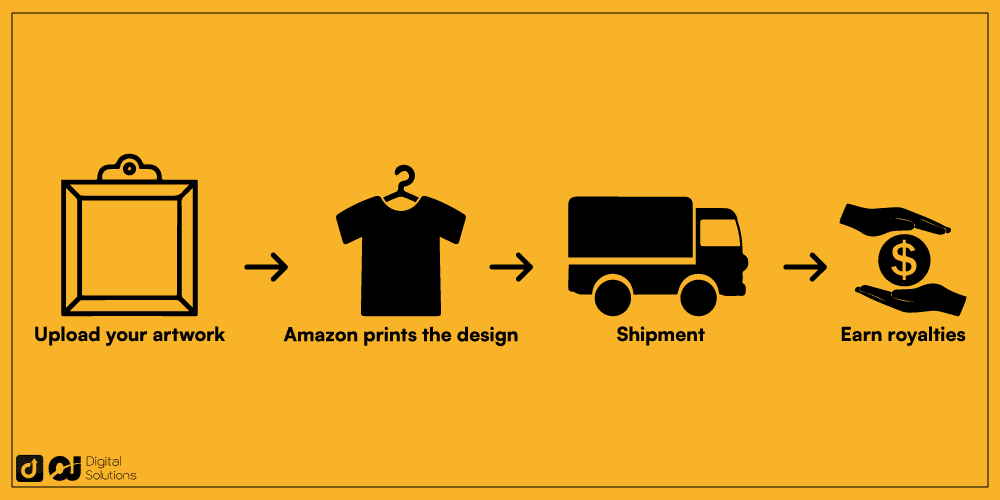
Merch on Demand, also called Merch by Amazon, is a print-on-demand service to help artists, content creators, and entrepreneurs sell their designs through graphic tees, coffee mugs, and other accessories.
With this no-product Amazon system, you can learn how to sell shirts on Amazon without inventory or any other product with your design.
Simply put, Amazon Merch on Demand is a platform for graphic designers who want to sell their original artwork without any upfront cost.
If you wish to use this print-on-demand service, you must request an invitation by filling out an application. Amazon will send you an email to notify you whether it approves or rejects your request.
Here’s how to get started with Merch by Amazon:
Create an Amazon seller account.
Log in to your Amazon account and navigate to the Merch by Amazon page.
Tap Request Invitation.
Accept the services agreement.
Tap Begin Application.
Provide your business information and answer the questions.
Submit your application.
Although anyone can fill out an application form, it’s tough to get in. Also, waiting for Amazon’s feedback usually takes several months.
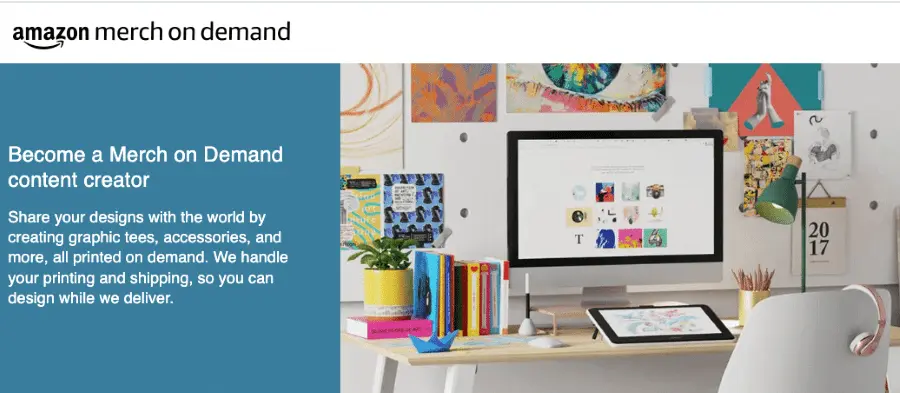
Pros of Becoming an Amazon Merch on Demand Creator
As an Amazon no-product platform, you can begin selling print-on-demand products without the need to purchase inventory.
Amazon handles everything for you as if your online business runs on autopilot mode.
You can sell your unique designs on a global platform.
The online platform rewards sellers with excellent sales by promoting them up the tier level. Initially, you can only upload ten designs before you can progress from selling 10, 25, 100 designs, and so on.
Cons of Becoming an Amazon Merch on Demand Creator
The print-on-demand service works on an invitation basis only. Getting in is tough.
You need to be careful with intellectual property rights, which can be tricky with so many designs flooding the market that it’s hard to identify which ones have a trademark.
Amazon has the right to ban your seller account permanently if you infringe on other artists’ trademarks.
Merch on Demand is a highly competitive market. It’s not uncommon for sellers to upload their artwork and generate no ecommerce sales for months on end.
The Cost of Becoming an Amazon Merch-on-Demand Creator
Merch by Amazon is worth considering if you want to know how to sell on Amazon without products and zero upfront cost.
However, you may have to shell out some cash for your initial investments, such as the digital art software you’ll need to create original designs.
| Types of Fees | Price |
|---|---|
| Amazon commission fees | 70 to 90%, depending on product type |
| Digital art software | varies |
Sell Digital Products.
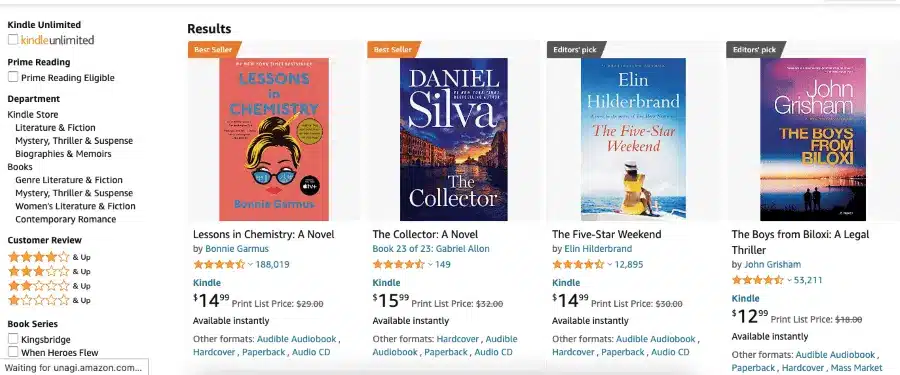
If you’re curious about how to sell products on Amazon without inventory, you may want to consider digital products, like ebooks and downloadable audiobooks.
Selling ebooks is the most popular method. They are relatively easy to produce and distribute on Amazon, thanks to the platform’s Kindle Direct Publishing (KDP) service.
KDP gives authors up to 70% royalties. Moreover, it does not require a hefty upfront fee, unlike traditional publishers.
Other ideas you can consider are:
Software and apps for computers and mobile phones
Digital artwork
Software templates
Music and audio tracks
Here’s a quick guide on how to become an Amazon seller without inventory by selling digital art and other products:
Do some research. Make sure there is a market for the digital product you wish to sell. Learning about your competitors and content creators who sell similar products is also helpful.
Create your digital product based on the needs and wants of your target audience. Ideally, launch an MVP (minimum viable product) to get customer feedback. That way, you can tweak and improve your digital product.
Upload your product. You can only do this if you already have a seller account on Amazon.
Pros of Selling Digital Products on Amazon
If you want to know how to sell stuff on Amazon without inventory, digital products are an excellent option.
You can avoid shipping costs.
You can sell digital products repeatedly without much effort, making them a perfect source of passive income.
Digital products are flexible. For example, customers can print your digital artwork based on the size of their frame.
Cons of Selling Digital Products on Amazon
Because the digital market is quite saturated, it isn’t easy to stand out.
Although selling digital products generally involves low upfront costs, you need to price them significantly cheaper than their physical versions.
Digital products are an easier target of piracy than physical products. However, you can protect yourself by keeping the original files of your work and registering the copyright to all your creations.
Some people prefer physical products to their digital versions.
The Cost of Selling Digital Products on Amazon
Although selling digital products on Amazon does not involve an upfront cost, you need to invest in technology tools (and time) to create your work.
You may also have to pay freelancers if you choose to outsource some tasks, like editing or graphic design.
| Types of Fees | Price |
|---|---|
| Amazon Referral Fees | Minimum $0.30 or 8 to 20% of the sale price |
| Amazon Seller Plan Fees | Individual Plan: $0.99/unit or Professional Plan: $39.99 |
| Software Costs* | varies |
| Professional Fees* | varies |
*Optional
Sell on Amazon FBA Without Inventory.
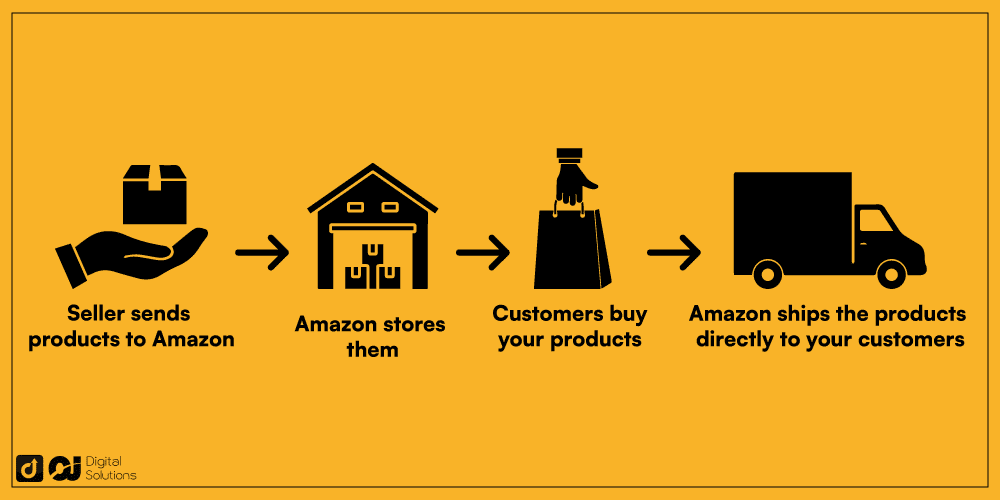
An Amazon FBA business helps sellers outsource fulfillment processes to Amazon. Every time your customers place orders, the company packs, ships, and provides customer services on your behalf.
If you use the Amazon FBA platform, your qualified product listings can also display the Prime badge, letting your customers know they are eligible for free, two-day shipping.
This process involves buying inventory at the beginning, so it has higher risks. Its benefit lies in making it possible for your business processes to be handled online.
If you want to know how to sell things on Amazon without inventory through Amazon FBA, this is how the program works.
You buy wholesale products from an online retailer or through retail arbitrage, where you buy items from retail stores at a lower price.
You send your products to an Amazon warehouse or fulfillment center.
When a customer orders your product, the Amazon fulfillment center handles the entire transaction for you, including payment and inventory management.
Next, the employees in Amazon’s warehouse pick up your product on its shelves, pack it, and ship it to your customer.
Receive payment. Amazon deducts seller fees and deposits your profits into your bank account every two weeks.
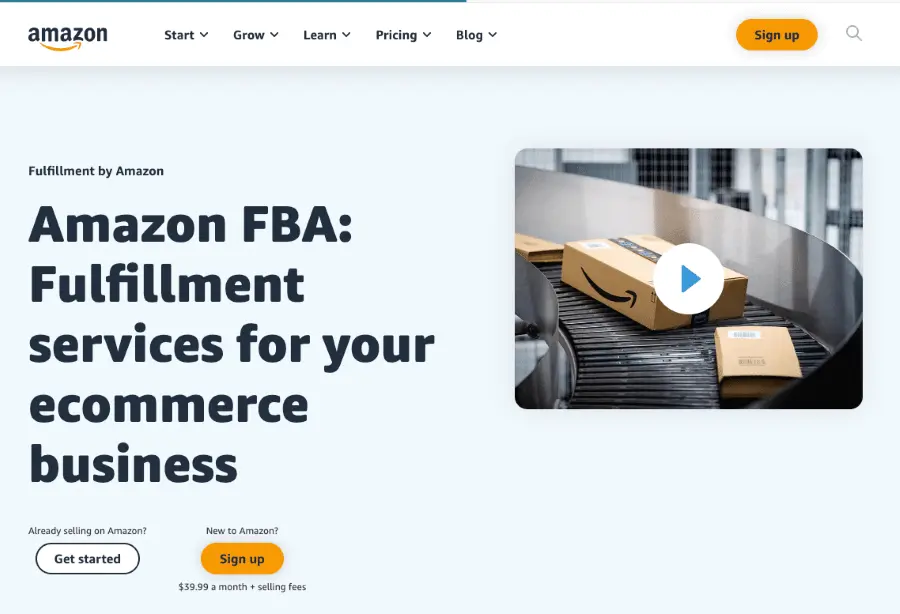
Pros of Using the Amazon FBA Program
On average, Amazon FBA sellers pay 32% less per unit on their shipment cost than other alternatives.
As an FBA seller, you can enjoy a flexible program that allows you to enroll in as many or as few products as you’d like.
Amazon handles fulfillment, customer returns, and customer service responses on your behalf.
You can target Amazon Prime customers looking for fast shipping services.
Cons of Amazon FBA Inventory
Amazon FBA fees can eat a huge chunk of your profit. The cost is even higher if you have slow-selling products because you must pay long-term storage fees.
Amazon FBA sellers typically have higher product returns due to the company’s no-questions-asked return policy.
Being an FBA Amazon seller may result in complex sales tax.
It requires specific packaging and labeling standards for products entering Amazon fulfillment centers.
The Cost of Using Amazon FBA
Amazon charges certain FBA fees to cover the inventory, packaging handling, and shipping costs.
You also need to purchase the Professional Plan, and pay for a unique product code to enter Amazon Marketplace.
| Types of Fees | Price |
|---|---|
| Amazon Referral Fees | 8 to 25% of the sale price |
| Amazon Seller Plan Fees | Professional plan: $39.99/month |
| Unique product code | At least $30 |
| FBA fulfillment fee | Starting at $4.75 per unit |
| Inventory storage fee | Starting at $0.83 per cubic foot |
| International shipment fee | Starting at $4.99-$10.99, depending on the country |
Hire a Third-Party Logistics (3PL) Company.
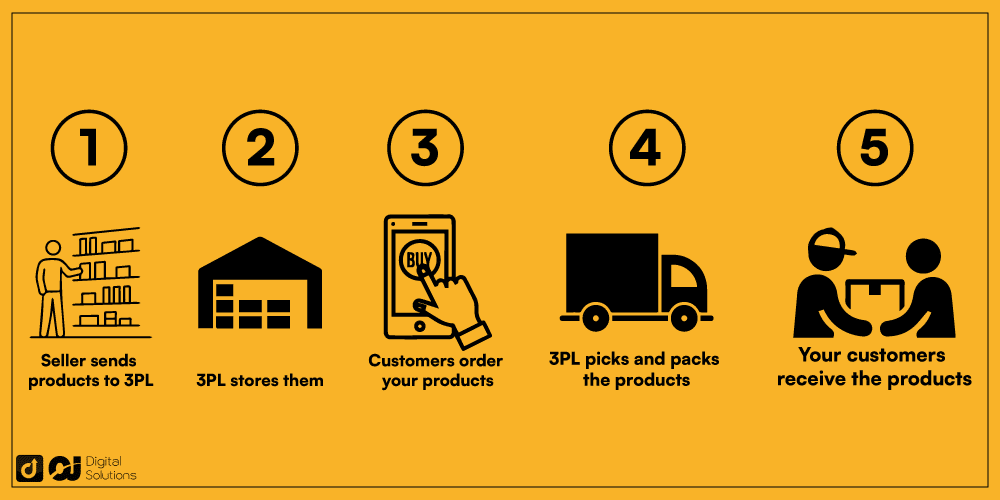
If you want to learn how to buy and sell on Amazon without inventory, you may want to consider working with a third-party inventory solutions provider.
A 3PL handles your logistical and supply chain operations, from receiving and updating your inventory to packing and shipping customer orders—similar to what FBA Amazon offers.
However, hiring a 3PL gives you more control and flexibility over your fulfillment process than working with Amazon FBA.
This is how a third-party fulfillment center works:
You send your inventory to the 3PL from your warehouse storage, or your suppliers or manufacturers send the products directly to these fulfillment solutions providers.
The 3PL receives, organizes, and stores the goods in its own warehouse space.
Once a customer places an order, the seller manually submits the order to the 3PL, or the provider receives it automatically through an integration software.
The 3PL picks the ordered products and packs them for shipment, along with receipts. It forwards the shipments to carriers like UPS, FedEx, USPS, and DHL.
Pros of Hiring a 3PL Service
You can reduce your shipping fees if you work with a 3PL company with multiple warehouses in the country.
You can access technology tools to manage your inventory daily.
Partnering with a 3PL means you have a group of experts helping you distribute your products.
Most 3PL providers can handle B2B and B2C fulfillment and support multiple sales channels, including Amazon, Shopify, and even brick-and-mortar stores.
Many sellers with 3PL providers enjoy lower shipping and storage rates than they could find on their own.
Cons of Hiring a 3PL Service
The upfront costs with a 3PL are often expensive.
3PLs are not ideal for new Amazon sellers who don’t know their potential order volume. If you don’t get many orders each month, the storage fee can eat up your profit margin.
The Costs of Hiring a 3PL Service
These companies use different pricing options, from flat rate to pricing by kit, per project basis, or per shelf.
While most 3PLs offer variable plans, others use flat-rate plans, which charge per order, monthly, or by shipment. The fee covers fulfillment, shipping, packing, customer service, inventory management, and customer returns.
| Types of Fees | Average Price |
|---|---|
| Setup fee, which is a one-time payment for software integration, training, warehouse storage tour, etc | $336 – $575 |
| Warehouse space fee | $0.85 – $1.50 per square foot per month |
| Receiving fee, which can be an hourly rate for uploading and managing inventory, or a flat fee per delivery or per SKU (stock keeping unit) | $25 – $50 per hour or $5 – $15 per pallet |
| Fulfillment fee, which covers picking, packaging, and labeling | Around $2.50 per SKU or 25 cents per item |
| Shipping process fee | Usually 10-30% lower than doing your shipment on your own |
How To Promote Your Amazon Products
While Amazon is one of the best marketplaces in terms of conversion rates, it’s also a saturated market. So if you want to know how to sell items on Amazon without inventory and generate impressive sales, you must stand out from the competition.
Here are the most effective strategies to promote your Amazon products and generate more sales.
Conduct Keyword Research (Amazon SEO).
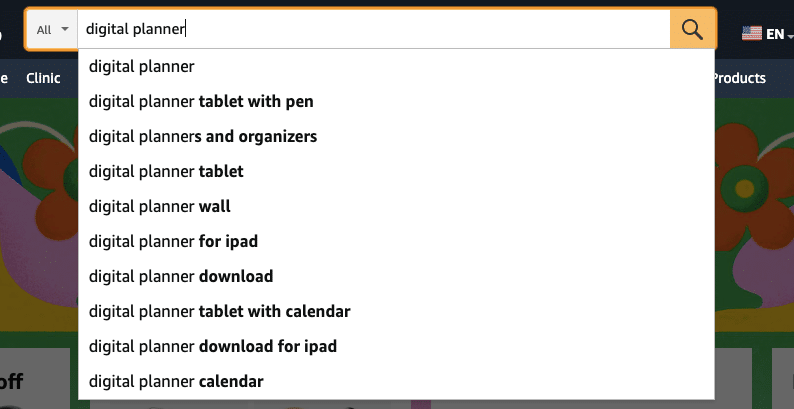
Search engine optimization, or SEO, is the key to helping your target customers find your content/product listing. This process of improving your traffic can also help you with product selection.
When choosing the most relevant product keywords for your listing, consider what your target customers may be using. Alternatively, you can use these popular Amazon keyword tools to improve the visibility and ranking of your products.
Helium10
Zonguru
SellerApp
Wordtree
KeywordToolDominator
Run Amazon PPC Ads.
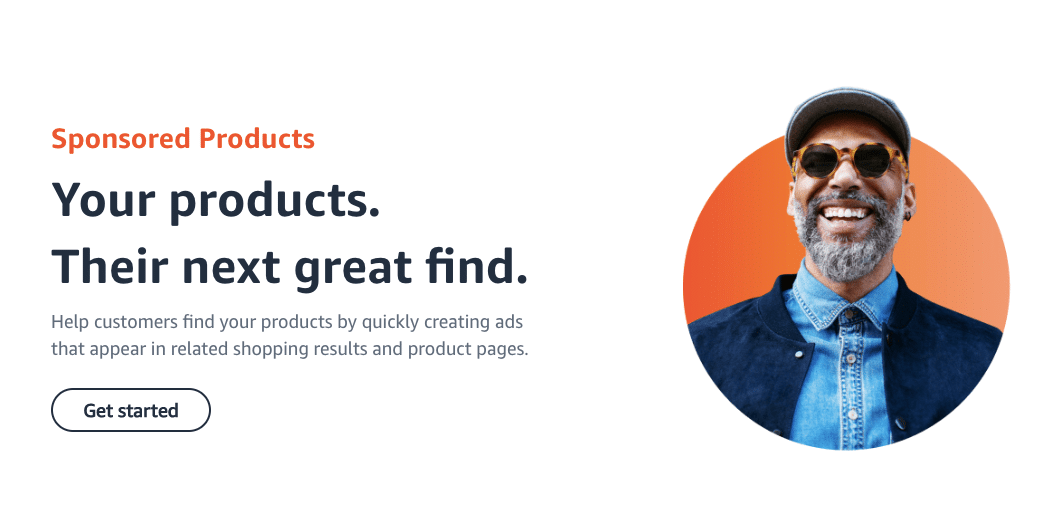
Amazon Pay-Per-Click (PPC) advertising helps you target specific keywords, allowing your product to appear on top of Amazon’s search results and competitor product listings.
Take Advantage of Email Marketing.
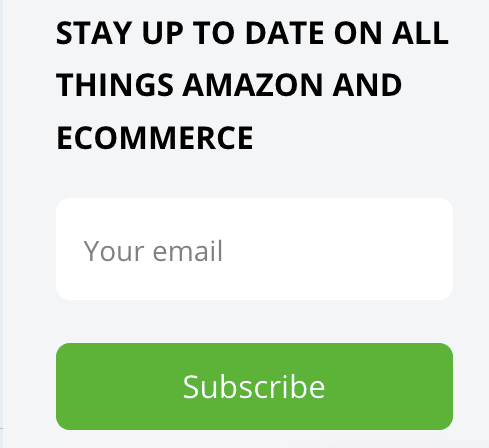
Direct email marketing allows you to communicate with your target audience and let them know about your newest products, discounts, and promotions.
Direct email marketing usually enjoys a higher conversion rate than unsolicited commercial emails because the recipients or subscribers have permitted the sellers to send them emails.
Share Your Products on Social Media.
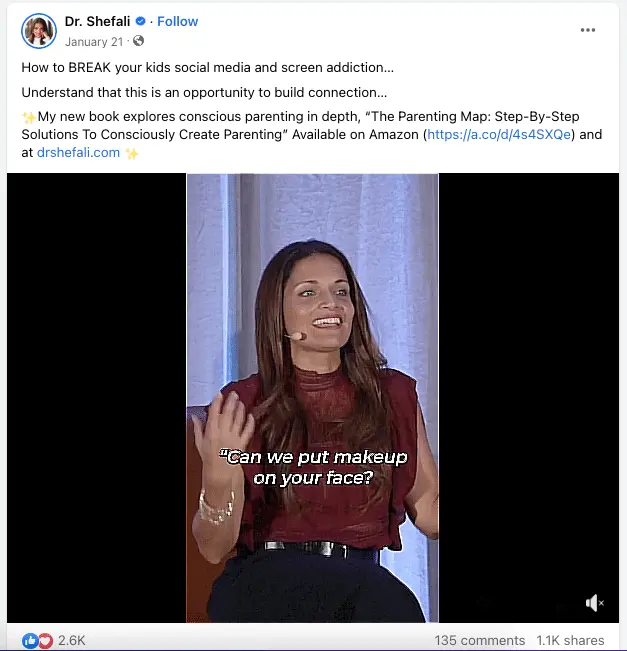
You can use outside channels like social media to drive traffic to your Amazon listings, allowing your target audience to see your products even though they are not on the marketplace platform.
Aside from social media, you can also use other external channels like Google Ads and blogs to drive traffic to your Amazon store.
Run Lightning Deals.
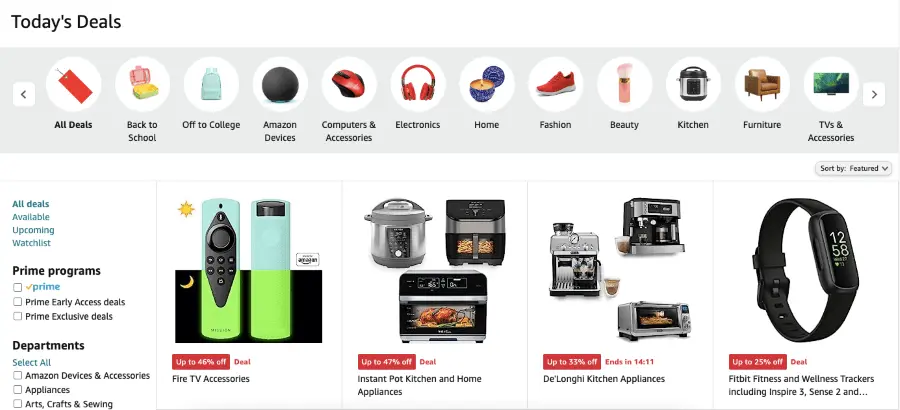
Amazon’s Lightning Deal page allows shoppers to find deals on the products they wish to buy. On the other hand, it lets many sellers reduce their inventory quickly, increase their sales, and improve their brand awareness.
The cost of Lightning Deals primarily depends on the Date Range you choose. To view your fee details, navigate to Seller Central > Reports > Payments > Transaction View > Service Fees.
Frequently Asked Questions (FAQs)
How To Sell Amazon Without Investment?
There are two ways to earn money on Amazon without a significant investment or a physical product in your warehouse: You can either sell a dropshipping website’s products or list digital products like ebooks, apps, software, digital artwork, music, or audio tracks.
Do You Have to Pay To Start Selling on Amazon?
It depends. If you sign up for Amazon’s FBA program, you must pay a fixed monthly fee of $39.99. But if you choose other ways to sell on Amazon without inventory, you may want to start with the Individual Plan.
With the Individual Plan, you only pay $0.99 every time you sell a product.
What Is the Minimum Inventory for Amazon FBA?
There is no minimum requirement for inventory volume when using Amazon FBA. In fact, you can even send just one item to its fulfillment center. To learn how to maximize this program, I recommend signing up for an Amazon FBA course.
Can I Sell on Amazon Without Owning a Business?
Yes. You can register as a seller on Amazon even if you don’t have a company. For this reason, the marketplace is ideal if you’re just selling a limited number of products or you only plan to sell seasonally.
How Difficult and Competitive Is It To Sell Products on Amazon?
The answer depends on the type of product you want to sell. As a general rule, generating sales is easier if you sell unique or hard-to-find products than listing ordinary items in a saturated market.
Pay close attention to your pricing, product selection, customer demand, customer service, ads, and content quality to make yourself competitive.
Is Selling on Amazon a Profitable Business?
Yes, if you do it right. In fact, over 65,000 US Amazon sellers generated more than $100,000 in sales in 2020, while the number of those who surpassed the $10 million sales benchmark increased by around 40% in the same year.
How To Sell Products on Amazon with Your Own Warehouse?
You can list and sell products on Amazon and ship them from your warehouse (or an external warehouse) by choosing Fulfilled by Merchant (FBM) instead of Fulfilled by Amazon (FBA). This way, you can set your own pace and have more control over your price and profit margins.
The Bottom Line
Now that you know how to sell products online without managing physical stock, you can start an Amazon business with low capital.
From dropshipping to print-on-demand to Amazon FBA, review each option to see which method works best for you. The key lies in understanding your target audience, conducting thorough market research, and monitoring other online stores to create strategies that stand out.

